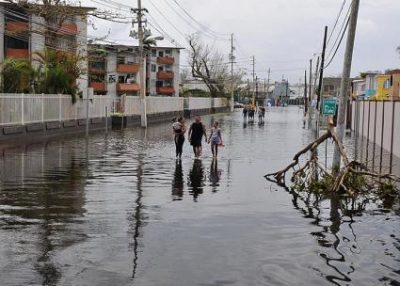Video: Puerto Rico Faces a Flood of Fracked Gas in Wake of Hurricane Maria
The gas industry and its allies in Congress hope to push LNG exports to the island’s electricity grid, ravaged from climate change-fueled natural disaster

Dimitri Lascaris: This is Dimitri Lascars reporting for The Real News Network.
Media have descended on Puerto Rico since Hurricane Maria devastated the island a year and a half ago, and many reported on its struggle to rebuild its energy grid. But behind the scenes, some policymakers and fossil fuel industry leaders are using the crisis to transform Puerto Rico into a hub for liquefied natural gas–gas obtained from hydraulic fracturing, or fracking, in the mainland United States.
Speaker: To rebuild the devastation of Hurricane Maria, this LNG has potential to reshape the Puerto Rican grid, making it safer and more reliable.
DL: Climate activists have decried these efforts.
S: The interest of the gas producers in the United States pushing for a gas market in Puerto Rico for their products.
DL: Liquefied natural gas, or LNG, is methane gas that’s been super chilled to a liquid state. It gets shipped via tankers from oceanic ports. LNG export shipments from the U.S. have greatly expanded in the fracking area. That tie to the fracking drilling method has not been lost on advocates in Puerto Rico.
S: Trying to sell us that gas is clean energy, and it’s not. Especially the gas that comes from the United States, which is fracking gas. That is dirty gas because of the effect it’s causing on the environment.
DL: Industry supporters tout natural gas as a more climate-friendly fossil fuel and potential “bridge fuel” to a renewable energy future.
Video: Energy Source carries tremendous benefits for consumers and the environment. It is versatile, clean burning, and abundant.
DL: Yet scientists fear that gas infrastructure could pose a major climate threat due to its capacity to lock in a long-term supply chain.
S: Scientists know that methane traps about 87, I’ve also seen 90, times as much carbon–as much heat as carbon would, over a 20 year period. And that’s really what’s important. It’s the short-term, the short-lived climate pollutants like methane that are really going to pack the biggest punch over the short term.
DL: Despite those concerns, Puerto Rico included the buildout of three LNG import terminals as a central component of its Integrated Resources Plan, the plan for its energy grid published in February.
S: There’s so much of it people have described it as a glut of natural gas in the U.S. There are people and corporations interested in making Puerto Rico the natural gas hub, or the fracked gas hub, of the Caribbean.
DL: And the Trump administration has made it easier to export LNG to the island by reclassifying tankers as “small scale.” It’s a move allowing gas to flow via deregulation. A new classification of LNG tankers dubbed “small scale” are now considered in the public interest under the Natural Gas Act of 1938 as a result of a regulation published in July by the Energy Department. That fast track means companies no longer have to go through public hearings for their project proposals, or pass an environmental review when aiming to export small-scale LNG.
In its press release announcing the rule, U.S. Secretary of Energy Rick Perry cited the Caribbean market as a key destination of small-scale LNG.
Though billed as small scale, the actual size of the shipments are as big, if not bigger, than conventional LNG exports. Meg Gentle, CEO of the company Tellurian, which specializes in small-scale LNG exports, explained it herself at a 2017 event.
Meg Gentle: LNG construction is a massive economies of scale business, and there are some projects that talk about small scale. And in fact, we did some research on trying to reduce the size of the plant, to bring smaller quantities into market as the market grows. What we learned is that there really are no economies of small.
DL: These efforts have triggered ire for the Puerto Rican climate activists.
S: The politicians publicly is we shouldn’t build our future on the top of the people who are being harmed in the north.
DL: While Puerto Rico does have regulations in place promoting renewable energy, the country has failed to achieve its goals.
S: What is known as a renewable portfolio standard enacted into law in Puerto Rico, and those goals have not been met, not even by far. They haven’t been met. And so we’re still depending on, as I mentioned earlier, 97 percent to 98 percent fossil fuels.
DL: Some say that renewable energy, and solar energy in particular, should sit at the center of Puerto Rico’s future energy plans.
S: I think we are advancing. I think we’re making some progress. I don’t think it’s fast enough. We are talking about being 100 percent renewable by by 2050. I think climate change won’t give us that amount of time. Climate change will push us towards it quicker than that.
DL: In the meantime, some Puerto Ricans have taken the transition into their own hands.
S: One of the things that we learned, one of the lessons that were definitely learned from the Hurricane Maria aftermath, is that communities need to play an active role and not be just passive consumers, but rather what are being called prosumers; that is, producers and consumers of energy. They need to, you know, use rooftops, especially, and other places close to the point of use for installations of photovoltaic systems, battery energy storage systems.
DL: With The Real News Network, I’m Dimitri Lascaris.
*
Note to readers: please click the share buttons below. Forward this article to your email lists. Crosspost on your blog site, internet forums. etc.
Featured image is from SocialistWorker.org

